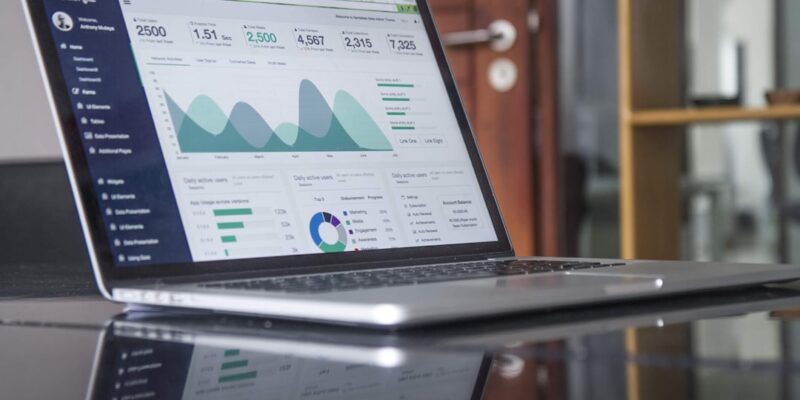
Maximizing ROI: Predictive Analytics for Investment Decisions
Predictive analytics is the practice of using historical data, statistical algorithms, and machine learning techniques to make predictions about future events or outcomes. In the context of investment decisions, predictive analytics can be a powerful tool for investors to gain insights and make informed decisions. By analyzing historical data and identifying patterns, predictive analytics can help investors identify profitable investment opportunities and minimize risks.
Key Takeaways
- Predictive analytics can help investors make informed decisions by analyzing data and predicting future outcomes.
- ROI is a crucial factor in investment decisions, as it measures the profitability of an investment.
- Predictive analytics can maximize ROI by identifying patterns and trends in data to make more accurate predictions.
- Key techniques for predictive analytics in investment decisions include regression analysis, decision trees, and neural networks.
- Data collection and analysis are essential for accurate predictive analytics, and it’s important to ensure data quality and relevance.
Understanding ROI and its Importance in Investment Decisions
Return on Investment (ROI) is a financial metric that measures the profitability of an investment relative to its cost. It is calculated by dividing the net profit of an investment by its initial cost and expressing it as a percentage. ROI is an important factor in investment decisions because it helps investors assess the potential return they can expect from an investment and compare it with other investment options.
Predictive analytics can play a crucial role in maximizing ROI by providing insights into the factors that drive profitability. By analyzing historical data and identifying patterns, predictive analytics can help investors identify the key variables that have a significant impact on ROI. This information can then be used to make informed decisions about which investments are likely to generate the highest returns.
The Role of Predictive Analytics in Maximizing ROI
One of the key ways predictive analytics can help maximize ROI is by identifying profitable investment opportunities. By analyzing historical data and identifying patterns, predictive analytics can help investors identify trends and patterns that indicate potential opportunities for high returns. For example, predictive analytics can analyze historical stock price data to identify stocks that are likely to increase in value in the future.
In addition to identifying profitable opportunities, predictive analytics can also help minimize risks and losses. By analyzing historical data and identifying patterns, predictive analytics can help investors identify potential risks and take proactive measures to mitigate them. For example, predictive analytics can analyze historical market data to identify periods of high volatility or market downturns, allowing investors to adjust their investment strategies accordingly.
Key Predictive Analytics Techniques for Investment Decisions
| Technique | Description | Advantages | Disadvantages |
|---|---|---|---|
| Regression Analysis | A statistical method used to identify the relationship between a dependent variable and one or more independent variables. | Provides a quantitative measure of the relationship between variables. Can be used to forecast future values. | Assumes a linear relationship between variables. Requires a large sample size to be accurate. |
| Decision Trees | A graphical representation of a decision-making process that uses a tree-like model of decisions and their possible consequences. | Easy to understand and interpret. Can handle both categorical and numerical data. | Can be prone to overfitting. May not be suitable for complex problems. |
| Neural Networks | A machine learning technique that uses a network of interconnected nodes to simulate the function of a human brain. | Can handle large amounts of data and complex relationships between variables. Can learn from experience and improve over time. | Can be difficult to interpret. Requires a large amount of computational power and time to train. |
| Time Series Analysis | A statistical method used to analyze and forecast trends in time-based data. | Can identify patterns and trends in data over time. Can be used to forecast future values. | Assumes that the data is stationary and that there are no external factors affecting the data. |
There are several key predictive analytics techniques that can be used for investment decisions. These include regression analysis, time series analysis, machine learning algorithms, and decision trees.
Regression analysis is a statistical technique that examines the relationship between a dependent variable and one or more independent variables. It can be used to predict the value of a dependent variable based on the values of independent variables. In the context of investment decisions, regression analysis can be used to predict the future value of an investment based on historical data.
Time series analysis is a statistical technique that examines patterns in time series data, which is data collected over time. It can be used to forecast future values based on past values. In the context of investment decisions, time series analysis can be used to predict future stock prices or other financial indicators.
Machine learning algorithms are a set of algorithms that can learn from data and make predictions or take actions without being explicitly programmed. They can be used to analyze large amounts of data and identify patterns that may not be apparent to humans. In the context of investment decisions, machine learning algorithms can be used to analyze historical financial data and identify patterns that indicate potential investment opportunities.
Decision trees are a type of machine learning algorithm that uses a tree-like model of decisions and their possible consequences. They can be used to make predictions or classify new instances based on historical data. In the context of investment decisions, decision trees can be used to classify investments as high-risk or low-risk based on historical data.
Data Collection and Analysis for Predictive Analytics
Data quality is crucial for predictive analytics because the accuracy and reliability of predictions depend on the quality of the data used. It is important to ensure that the data collected is accurate, complete, and representative of the problem being analyzed. Data sources for predictive analytics can include financial statements, market data, economic indicators, and social media data.
Data cleaning and preprocessing are important steps in the data analysis process. This involves removing any errors or inconsistencies in the data, handling missing values, and transforming the data into a suitable format for analysis. Exploratory data analysis is also an important step in the data analysis process, as it helps to identify patterns, relationships, and outliers in the data.
Developing Predictive Models for Investment Decisions
Once the data has been collected and analyzed, the next step is to develop predictive models. Model selection involves choosing the most appropriate model for the problem being analyzed. This can involve selecting from a range of different models, such as regression models, time series models, or machine learning models.
Model training and validation involve using historical data to train the model and evaluate its performance. This involves splitting the data into a training set and a validation set, and using the training set to train the model and the validation set to evaluate its performance. Hyperparameter tuning involves adjusting the parameters of the model to optimize its performance.
Model interpretation is an important aspect of predictive analytics because it helps investors understand how the model is making predictions. This can involve analyzing the coefficients or weights assigned to different variables in a regression model, or analyzing the decision rules in a decision tree model.
Evaluating the Accuracy of Predictive Models
Evaluating the accuracy of predictive models is an important step in the predictive analytics process. There are several metrics that can be used to evaluate model accuracy, including mean squared error (MSE), root mean squared error (RMSE), mean absolute error (MAE), and R-squared.
Overfitting and underfitting are common problems in predictive modeling. Overfitting occurs when a model performs well on the training data but poorly on new, unseen data. Underfitting occurs when a model is too simple and fails to capture important patterns in the data. Cross-validation techniques can be used to address these problems by evaluating the performance of the model on multiple subsets of the data.
Implementing Predictive Analytics in Investment Strategies
Implementing predictive analytics in investment strategies involves integrating predictive analytics into existing investment processes. This can involve automating the data collection and analysis process, using predictive models to generate investment recommendations, and incorporating these recommendations into investment decision-making.
Automation and scalability are important considerations when implementing predictive analytics in investment strategies. Automation can help streamline the data collection and analysis process, allowing investors to analyze large amounts of data more efficiently. Scalability is important because as the amount of data increases, the computational resources required to analyze the data also increase.
Risk management and compliance are also important considerations when implementing predictive analytics in investment strategies. Predictive analytics can help identify potential risks and take proactive measures to mitigate them. Compliance with regulatory requirements is also important to ensure that investment decisions are made in accordance with applicable laws and regulations.
Real-World Examples of Successful Predictive Analytics in Investment Decisions
There are many real-world examples of successful predictive analytics in investment decisions. One example is stock price prediction, where predictive analytics can be used to analyze historical stock price data and identify patterns that indicate potential future price movements. Another example is portfolio optimization, where predictive analytics can be used to analyze historical financial data and identify the optimal allocation of assets to maximize returns and minimize risks.
Credit risk assessment is another area where predictive analytics can be applied. By analyzing historical credit data, predictive analytics can help lenders assess the creditworthiness of borrowers and make informed decisions about lending. Fraud detection is another area where predictive analytics can be applied, by analyzing historical transaction data and identifying patterns that indicate potential fraudulent activity.
Challenges and Limitations of Predictive Analytics in Investment Decisions
There are several challenges and limitations of predictive analytics in investment decisions. One challenge is data availability and quality, as accurate and reliable data is crucial for accurate predictions. Another challenge is model interpretability and transparency, as complex models can be difficult to understand and explain.
Overreliance on historical data is another limitation of predictive analytics, as it assumes that the future will be similar to the past. However, market conditions and other factors can change over time, making historical data less relevant. Human biases and errors are also a limitation of predictive analytics, as human judgment and decision-making can introduce biases and errors into the analysis.
Predictive analytics is a powerful tool for investors to gain insights and make informed decisions. By analyzing historical data and identifying patterns, predictive analytics can help investors identify profitable investment opportunities and minimize risks. However, there are challenges and limitations to consider, such as data availability and quality, model interpretability and transparency, overreliance on historical data, and human biases and errors. Despite these challenges, the future outlook for predictive analytics in investment decisions is promising, as advancements in technology and data analytics continue to improve the accuracy and reliability of predictions.
FAQs
What is predictive analytics?
Predictive analytics is the use of statistical algorithms and machine learning techniques to analyze historical data and make predictions about future events or trends.
How is predictive analytics used in investment decisions?
Predictive analytics can be used to analyze financial data and make predictions about future market trends, stock prices, and investment opportunities. This can help investors make more informed decisions and potentially increase their returns.
What types of data are used in predictive analytics for investment decisions?
Data used in predictive analytics for investment decisions can include financial statements, market data, economic indicators, and other relevant information.
What are some benefits of using predictive analytics in investment decisions?
Some benefits of using predictive analytics in investment decisions include improved accuracy in predicting market trends and investment opportunities, reduced risk, and potentially higher returns.
What are some potential drawbacks of using predictive analytics in investment decisions?
Potential drawbacks of using predictive analytics in investment decisions include the possibility of inaccurate predictions, overreliance on data and algorithms, and the risk of missing out on opportunities that may not fit within the predicted trends.
What are some examples of companies using predictive analytics for investment decisions?
Companies such as BlackRock, JPMorgan Chase, and Goldman Sachs are known to use predictive analytics in their investment decision-making processes.


















